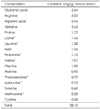1. Ann DK. Color Illustrated Korean Medicinal Plants Book. 1998. 7th ed. Seoul: Gyohaksa;143.
2. Association of Korean Professor of Oriental Medicine Prescription. Oriental Medicine Prescription. 1999. Seoul: Youngumsa;1068.
3. Soka T. In Dictionary of Chinese Drugs. 1985. 1st ed. Shanghai Science Technology Shogakukan Press.
4. Seto M, Miyasa T, Fukushima S. Sesquiterpenelactones from Ixeris dentata Nakai. Chem Pham Bull. 1986. 34:4170–4175.
5. Kim SH. Inhibitory effect of lxeris Dentata on the mutagenicity of aflatoxin B1, N-methyl-N'-nitro-N-nitrosoguanidine and the growth of MG-63 human osteosarcoma cells. J Korean Soc Food Sci Nutr. 1995. 24(2):305–312.
6. Kim MJ, Kim JS, Kang WH, Jeong DM. Effect on antimutagenic and cancer cell growth inhibition of lxerisdentata Nakai. Korean J Med Crop Sci. 2002. 10(2):139–143.
7. Kim MJ, Kim JS, Jeong DM, Ham SS, Yu CY. Effect of antioxidant, antimutagenicity and anticancer of root extract from lxeris dentata Nakai. Korean J Med Crop Sci. 2002. 10(3):222–229.
8. Kim MJ, Kim JS, Cho MA, Kang WH, Jeong DM, Ham SS. Biological activity of lxeris dentata Nakai juice extracts. J Korean Soc Food Sci Nutr. 2002. 31(5):924–930.
9. Lim SJ. A Sensory evaluation of the bitter compounds from Ixeris dentata Nakai. Korean J Food Cookery Sci. 1996. 12(1):115–121.
10. Charley H. Foods-A scientific Approach. 1998. 3rd ed. Prentice-Hall;120–128.
11. Choi JS, Chung HY, Young HS. A preliminary study on hypocholesterolemic and hypoglycemic activities of some medical plants. Korean J Pharmacogn. 1990. 21:153–155.
12. Choi JS, Young HS, Kim BW. Hypoglycemic and hypolipodemic effects of Ixeris dentata in diabetes rats. Arch Pharm Res. 1991. 13:269–270.
13. Lee HJ, Lee DS, Seo Y. DPPH radical scavenging effect and in virto lipid peroxidation inhibition by Portulaca oleracea. Korean J Biotechnol Bioeng. 2003. 18(3):165–169.
14. Jang HJ, Yu AJ, Shin SC, Kim HK, Lee SG. Changes in total polyphenol contents and DPPH radical scavenging activity of Agriminia pilosa according to harvest time and various part. Korean J Med Crop Sci. 2008. 16(6):397–410.
15. Yu BC, Kim SS, Yun YH, Kim KY. A cytotoxity of carrier oil essential oils on cells by using of aromatherapy. J Korean Living Sci Assoc. 2008. 17(5):1027–1035.

16. Rhu HS, Kim KO, Kim HS. Effect of plant water extracr codonopsis
Lanceolatae on mouse cell activation
Ex vivo. Korean J Nutr. 2009. 42(3):207–212.

17. Jeon YH, Choi SW, Kim MR. Antimutagenic and cytotoxic activity of ethnol and water extracts from Rubus corenum. Korean J Food Cookery Sci. 2009. 25(3):379–386.
18. Lee KI, Kim SM. Anoxidative and antimicrobial activities of
Eribotrya japonica Lindl leaf extracts. J Korean Soc Food Sci Nutr. 2009. 38(3):267–273.

19. Choi HY. Antioxidant activity and quality characteristics of pine needle cookies. J Korean Soc Food Sci Nutr. 2009. 38(10):1414–1421.

20. Rhim TJ, Choi MY. The antioxidative effects of Oregano (Orianum majorana L). extracts. Korean J Plant Resour. 2009. 22(4):425–430.
21. Kim YE, Yang JW, Lee CH, Kwon EK. ABTS radical scavenging and anti-tumor effects of Tricholola matutake Sing (pine mushroom). J Korean Soc Food Sci Nutr. 2009. 38(5):555–650.
22. A.O.A.C.Official Methods of Analysis. 1990. 15th ed. VA: Association of official analytical chemists.
23. KFDA. Food code. 2000. 304–309.
24. Folin O, Denis W. On phosphotungustic phosphomolibdic compounds as color reagents. J Biol Chem. 1912. 12:239–241.
25. Folch J, Lees M, Sloane GH. A simple method for the isolation and purification of total lipids from animal tissues. J Biol Chem. 1957. 226:497–509.

26. Metcalf LD, Schumitz AA, Pelka JR. Rapid preparation of fatty acid esters from lipids for gas chromatographic analysis. Anal Chem. 1966. 38:514–516.

27. Hansen MB, Nielsen SE, Berg K. Re-examination and further development of a precise and rapid dye method for measurering cell growth/cell kill. J Immunol Methods. 1989. 119(2):203–210.

28. Blois MS. Antioxidant determinations by the use of a stable free radical. Nature. 1958. 26:1199–1203.

29. National Rural Living Science Istitute of Korea. Food Composition Table. 2001. 124–125.
30. Lim SS, Lee JH. A study on the chemical composition and hypocholesterolaemic effect of Asterscaber and Ixeris dentata. J Korean Soc Food Sci Nutr. 1997. 26(1):123–129.
31. Moon JS, Kim SJ, Park YM, Hwang IS, Kim EH, Park JW, Park IB, Kim SW, Kang SG, Park YK, Jung ST. Antimicrobial efect of methanol extracts from some medicinal herbs and the con-tent of phenolic compounds. Korean J Food Preserv. 2004. 11(2):207–213.
32. Sin YJ. Antioxidant and anti-imflammatory effects of fractions from dandelion (Taraxacumofficinale) leaf and roof [Master thesis]. 2007. Seoul: Seoul Nat'l Univ.
33. Chung KH, Yoon KR, Kim JP. Flavonoidal constituent in Korean Lactuca Dentata Makino. J Korean Soc Diet Cult. 1994. 9(2):131–135.
34. Lee HJ, Kim YA, Ahn JW, Lee BJ, Moon SG, Seo YW. Screening of peroxynitrite and DPPH radical scavenging activities from salt marsh Plants. Korean J Biotechnol Bioeng. 2004. 19(1):57–61.








 PDF
PDF ePub
ePub Citation
Citation Print
Print








 XML Download
XML Download